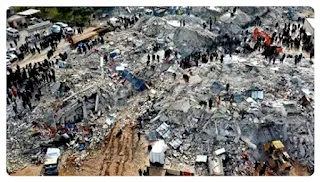Turkey-Syria Devastating Earthquake: Facts, Casualties and Damage
Turkey-Syria Devastating Earthquake: Facts, Casualties and Damage
An earthquake struck southern and central Turkey, as well as western Syria, on February 6, 2023. It happened 34 kilometres (21 miles) west of Gaziantep at 04:17 TRT (01:17 UTC), causing widespread damage and thousands of fatalities. The earthquake, which had a maximum Mercalli intensity of X (Extreme) and a magnitude of at least Mww 7.8, is tied with the 1939 Erzincan earthquake as the strongest recorded earthquake to hit Turkey in modern times and the deadliest earthquake to strike the country since the 1999 zmit earthquake. It is also one of the most powerful earthquakes recorded in the Levant. It has destroyed structures as far away as Ashdod, Israel, and Nicosia, Cyprus.
Following the earthquake, there were numerous aftershocks, including an unusually powerful Mww 7.5. More than 11,100 people have been killed in total, with 8,570 killed in Turkey and 2,751 killed in Syria.
Pic Can
Erok—AFP/Getty Images
Turkey and Syria Earthquakes
Mainshock
The earthquake happened at 01:17 UTC. The US Geological Survey (USGS) reported a magnitude of 7.8 Mww, while GEOSCOPE reported a magnitude of 8.0 Mw and the Global Centroid Moment Tensor (GCMT) reported a magnitude of 7.8 Mw. It had an epicentre 34 kilometres (21 miles) west of Gaziantep in Gaziantep Province, near the Syrian border. It is one of the strongest earthquakes ever recorded in Turkey, equaling the Erzincan earthquake of 1939 and possibly only surpassed by the North Anatolia earthquake of 1668. and the largest recorded globally since August 2021.
The focal mechanism of the shock corresponded to shallow strike-slip faulting. Rupture happened on a northeast-southwest striking and northeast dipping fault or a northeast-southwest striking and northwest dipping fault. The USGS estimated that the rupture was 190 km (120 mi) long and 25 km (16 mi) wide. According to a geophysics professor at Saudi Arabia's King Abdullah University of Science and Technology, the earthquake may have ruptured over 300 kilometres (190 miles) of fault. The East Anatolian Fault and the Dead Sea Transform are thought to have been ruptured.
According to a USGS source model, the earthquake ruptured two fault segments with a total length of more than 360 km (220 mi). The rupture occurred on a 60-kilometer-long (37-mile-long) north-south striking, east-dipping fault near the Mediterranean coast. A 300 km (190 mi) segment striking northeast-southwest ruptured as well. The maximum slip produced by the mainshock was 3.4 m. (11 ft).
Aftershocks
About 11 minutes after the mainshock, a Mww 6.7 aftershock occurred. According to the USGS, there were 25 aftershocks Mw 4.0 or greater recorded within six hours of the main tremor. The USGS reported at least 54 aftershocks of magnitude 4.3 or greater more than 12 hours later, while the Turkish Disaster and Emergency Management Presidency (AFAD) recorded at least 120 aftershocks.
A major aftershock measuring Mww 7.5, or Mw 7.7 according to GEOSCOPE and the GCMT, occurred. It hit at 10:24 UTC, with an epicentre 4 kilometres (2.5 miles) north-northeast of Elbistan in Kahramanmaraş Province. It ruptured along an east-west striking, north dipping, east dipping strike-slip fault. According to the USGS, the earthquake may have ruptured a separate fault 120 km (75 mi) long and 18 km (11 mi) wide, and many early reports referred to it as a disparate earthquake rather than an aftershock. The responsible fault is not a part of the East Anatolian Fault. Two additional mb 6.0 aftershocks followed.
Small-magnitude aftershocks can be expected to continue for a year, according to an Australian scientist at the Seismology Research Centre. However, aftershocks that can cause severe shaking may occur for several days to weeks after the mainshock.
Gaziantep Castle prior to
the Kahramanmaras earthquake. (Photo: Muhur/Depositphotos)
Casualties and damage
In Turkey, at least 8,574 people were killed and 49,133 were injured across 10 provinces. A total of 13.5 million people and 4 million structures were affected. When buildings collapsed, thousands were trapped beneath the rubble. [61] Some of those trapped used social media to livestream their cries for help.
In Syria, at least 2,751 people were killed and 3,749 were injured. The Syrian Ministry of Health reported 1,331 earthquake-related deaths and 1,449 injuries in Aleppo, Idlib, Latakia, Hama, and Tartus provinces. More than 200 people were killed in Aleppo, Hama, and Latakia. At least 1,420 people were killed and 2,200 were injured in rebel-held areas.


.webp)

.webp)
.webp)
.webp)

.webp)